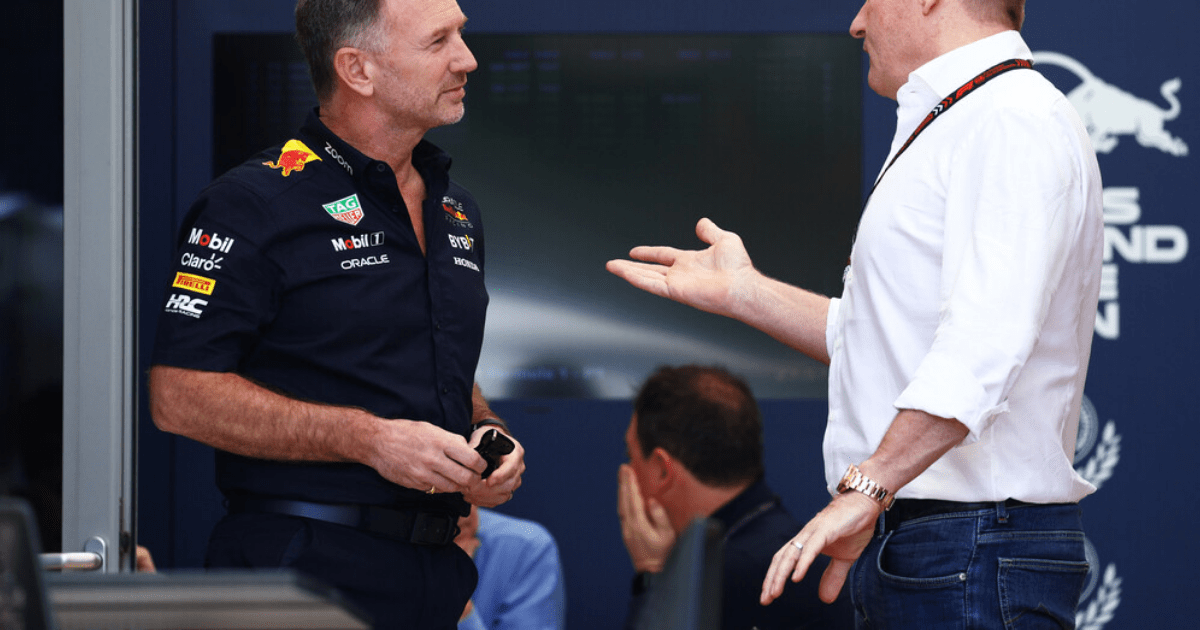Fiery Argument
Christian Horner and Max Verstappen's dad Jos were caught in a heated debate during the Formula One season opener, following reports of cracks in the Red Bull camp.
Tension Rising
Recent sexting scandal involving Horner has led to clashes with Jos Verstappen, who called for Horner's removal, warning that the team could be "torn apart."
Pressure Mounts
Rumors suggest ongoing clashes between Jos and Horner, with a fresh argument captured on Saturday, indicating widening cracks within the Red Bull team.
Explosive Situation
Jos Verstappen bluntly stated that the team could "explode" if Horner continues in his position, potentially leading to Max Verstappen making a switch to another team.

Support Amid Scandal
Horner, recently cleared of inappropriate behavior allegations, was joined by wife Geri Halliwell in Bahrain, displaying a united front amidst the controversy.
Team Drama Unfolds
Allegations of leaked messages, tensions within the team, and potential fallout for Max Verstappen paint a tumultuous picture for Red Bull Racing.
Frequently Asked Questions
Can Formula 1 teams buy cars from competitors?
Formula 1 teams usually design and manufacture their own cars. However, they can buy certain parts from competitors such as power units and transmissions. However, to ensure that the sport is competitive and diverse, certain parts are required by regulations. These include the chassis as well as aerodynamic surfaces.
What costs can be excluded from Formula 1’s budget cap?
Formula 1 teams are allowed some flexibility by excluding certain expenses from their budget caps. Exclusions usually include marketing expenses, driver salaries, salaries of the three top executives or personnel and costs associated with non F1 racing activities. Also excluded are capital expenditures, corporate income taxes and employee bonuses and benefits.
How has the introduction of hybrid power units affected Formula 1 team costs?
The advent of hybrid power systems in Formula 1 increased the complexity of the technology and consequently the cost associated with the sport. Since their introduction in 2014, the cost of teams has increased due to significant investments in development, production, and maintaining these hybrid engines. Since the introduction of hybrid engines in 2014, teams have had to increase their budgets to research and develop to stay competitive.
What is the price of a Formula 1 engine?
A Formula 1 motor is one of most sophisticated machines in the sport. Teams can spend up to $10 million just on the engine, which is the cost of the technology and performance required to compete at the highest levels.
Statistics
- The budget cap introduced in Formula 1 for the 2021 season was set at $145 million, which is aimed to level the playing field.
- The average cost to construct a Formula 1 car chassis is estimated to be between $10 million and $15 million.
- Formula 1 teams may spend up to $10 million on the engine alone, due to the high level of technology and performance required.
- The cost of a full-scale Formula 1 simulator can reach several million dollars, with annual maintenance adding to the financial impact.
- Pirelli F1 tires cost around $2,700 each, resulting in a set of four tires costing approximately $10,800.
- Racing suits worn by Formula 1 drivers can cost from $2,000 to $5,000, integrating high levels of safety and performance features.
- A Formula 1 team’s pit stop equipment can cost between $100,000 to $500,000 for high precision and speed during the race.
- An advanced Formula 1 steering wheel can cost between $50,000 to $100,000 given its multifunctionality and custom design.
External Links
jamesallenonf1.com
formula1.com
theverge.com
motorsport.com
businessinsider.com
skysports.com
grandprix247.com
redbull.com
How To
How to choose Formula 1 aerodynamic components
Formula 1 aerodynamic components are selected using a mix between wind tunnel and computer simulations. Discuss with aerodynamicists the importance of downforce versus drag reduction. Prioritize the components that balance car performance and stability on track. Test these designs in wind-tunnels to verify their real world efficiency. Be aware that the regulations restrict the degree of aerodynamic modification during the season. Decisions must be well-founded and based on accurate data. F1 homologation is required to ensure that manufacturers are in compliance with the regulations.

